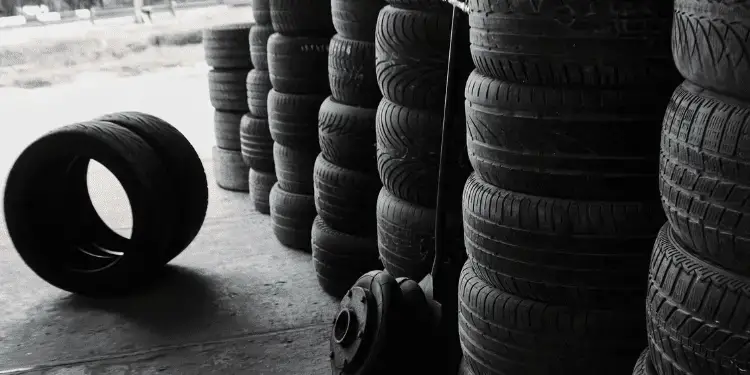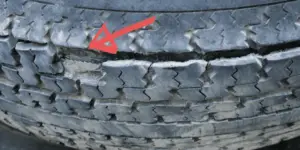Here we’ll examine the financial aspects of replacing all four tires at once, as well as the safety and time considerations of doing so.
If all four tires are close to the legal limit, is it always cheaper to replace them all at the same time? Often there are discounts for replacing all four at once. If you don’t replace tires that will soon become illegal, you’ll have to take another trip back to the tire shop within a few months to replace them, costing you more time.
If time, not money, is important to you, it makes perfect sense to get all four replaced. Business owners who need their vehicles on the road as much as possible will get tires replaced before they become too worn. It just makes economic sense.
Often you’ll see tire shop offers that read
“15% off 4 Tires”
If all your tires are close to the legal limit, it makes sense to take advantage of this.
Let’s do some basic math.
You find a tire deal that gives you 15% off four tires. Each tire costs $75, a total of $300 before the discount.
The discount is $45, so you pay a total of $255 for four tires.
This works out to be $63.75 per tire.
The tire shop also offers 5% off when you buy two tires at once. The total cost for two tires is $150 with a discount of $7.50, leaving $142.50 to pay.
This works out to be $72.50 per tire.
The key here is to assess the condition of the two better tires.
Knowing this lets you know whether it is more cost-effective to eke out a few thousand more miles on the tires or replace all four at once.
That leads us to:
Assessing Tread Depth of the Other Tires.
It’s difficult to know how much tread your tires have just by looking. Sometimes a dirty or faded tire can trick our brain into thinking a tire is less road worthy than a clean and dressed tire.
It’s a fine balancing act between getting as much wear from your tires as possible and them getting low on tread and not being as safe as you would like them to be.
Generally, 1/16 inch or 1 mm of tread should last between 1,000 miles and 4,000 miles.
Why the large difference?
A lot depends on the condition of the roads being driven on. Loose gravel roads will wear your tires quicker than highway driving, for instance. Driving style also has an impact. Quick acceleration and harsh braking will also wear the tires quicker.
The average American drives 13,500 miles per year, so a quick calculation we could make would be.
The minimum tire tread depth in most states is 2/32 inch or approximately 1.6 mm.
A car with 4/32 inches of tread left on it – driving on a mixture of roads where 1/16 of tread may last 2,500 miles – has 5,000 miles left before it becomes illegal if an average yearly mileage is 13,500 equates to around three and a half months.
How Do I Know How Much Tire Tread I Have Left?
So how much legal tread is there on the tires you are considering getting replaced – along with the ones you are getting replaced?
A really simple way of checking the tread depth is by placing a screw – either a 6/32 or a 8/32- in the gap between the tread and placing a fingernail on the screw where it meets the tread. Each rotation of the screw measures 1/32 inch.
Remove the screw from the tire and count the threads below your fingernail. If you count two threads, that indicates the tread is at the legal limit.
Four visible threads equate to 4/32, and roughly 5,000 miles of legal tread left. Here’s a video of a driver checking his tread with a screw.
A more accurate way is to use a tire tread gauge. They are very cheap but will give you a more accurate reading. Tire shops use these to measure tire depth.

Can I Replace Two Tires Instead Of All Four?
Sure. If two tires are above the legal limit, there is no reason why you can’t leave them on your car until they hit 2/32 inches.
If cost is a major concern here, but you’d like to replace all four tires, there is another option.
This is especially true if you live in a state where all seasons aren’t grippy enough, and you have to swap over to winter tires for six months of the year.
It’s fair to argue that if a set of tires aren’t on a car, they won’t wear, so there are no additional costs.
In reality, tires can dry out in storage. There are additional costs of more balancing, buying another set of rims, and even sometimes wheel alignment, so the costs can add up if you are on a budget.
So what’s the answer?

How To Buy A Set of Four Tires For The Cost Of Two
This won’t be for everyone, but it can make sense for those of us on a budget.
1 in 10 tires fitted on cars in the U.S is a used tire. Until 2015 most states had no laws regulating the use of used tires. Investigations discovered that some unscrupulous shops were selling tires that were completely unroadworthy and very dangerous.
This has been tightened up, and if you do your research, there are bargains to be had.
Prices are usually determined by the amount of tread remaining and the tire brand. If you’re only an occasional driver, a used tire could last for years before needing replacing.

A popular article with other visitors: Where Used Tire Shops Buy Their Tires From
Do Winter, All Seasons and Summer Tires Have The Same Legal Limit?
The legal limit for all seasons is usually the same for summer and winter tires, with some exceptions.
If you decide whether to replace two tires or all four of them, the time of year should be considered.
If it’s spring or summer with 4/32 of treads on your tires, it makes more sense to keep them until they reach the legal limit – if you’re a bit short of cash and can’t find any tire shop offers that work for you financially.
If, though, it’s the fall or winter you’d be better to get all four tires replaced if they are below 4/32.
Tires close to their legal limit will perform worse than tires with more tread. In winter, with ice, rain, and snow, it becomes more of a risk.
Here is some research on tires’ effectiveness in the winter with half tread remaining.



![How Long Do New Tires Take To Put On? [ANSWERED] Torque-wrench-tire](https://carzaza.com/wp-content/uploads/2023/12/Torque-wrench-tire-300x150.png)



![How Fast Can You Drive On A Patched Tire? [ANSWERED] tire-patch-repair](https://carzaza.com/wp-content/uploads/2023/12/tire-patch-repair-300x150.png)





